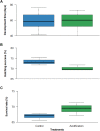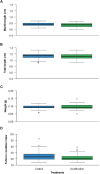Cuttlefish Early Development and Behavior Under Future High CO2 Conditions
- PMID: 31404314
- PMCID: PMC6676914
- DOI: 10.3389/fphys.2019.00975
Cuttlefish Early Development and Behavior Under Future High CO2 Conditions
Abstract
The oceanic uptake of carbon dioxide (CO2) is increasing and changing the seawater chemistry, a phenomenon known as ocean acidification (OA). Besides the expected physiological impairments, there is an increasing evidence of detrimental OA effects on the behavioral ecology of certain marine taxa, including cephalopods. Within this context, the main goal of this study was to investigate, for the first time, the OA effects (∼1000 μatm; ΔpH = 0.4) in the development and behavioral ecology (namely shelter-seeking, hunting and response to a visual alarm cue) of the common cuttlefish (Sepia officinalis) early life stages, throughout the entire embryogenesis until 20 days after hatching. There was no evidence that OA conditions compromised the cuttlefish embryogenesis - namely development time, hatching success, survival rate and biometric data (length, weight and Fulton's condition index) of newly hatched cuttlefish were similar between the normocapnic and hypercapnic treatments. The present findings also suggest a certain behavioral resilience of the cuttlefish hatchlings toward near-future OA conditions. Shelter-seeking, hunting and response to a visual alarm cue did not show significant differences between treatments. Thus, we argue that cuttlefishes' nekton-benthic (and active) lifestyle, their adaptability to highly dynamic coastal and estuarine zones, and the already harsh conditions (hypoxia and hypercapnia) inside their eggs provide a degree of phenotypic plasticity that may favor the odds of the recruits in a future acidified ocean. Nonetheless, the interacting effects of multiple stressors should be further addressed, to accurately predict the resilience of this ecologically and economically important species in the oceans of tomorrow.
Keywords: behavior; cuttlefish; early life stages; embryogenesis; ocean acidification.
Figures





Similar articles
-
Cuttlefish Buoyancy in Response to Food Availability and Ocean Acidification.Biology (Basel). 2020 Jul 1;9(7):147. doi: 10.3390/biology9070147. Biology (Basel). 2020. PMID: 32630264 Free PMC article.
-
Metabolomic and phenotypic effects of ocean acidification on cuttlefish differ across early life stages.Mar Environ Res. 2025 Mar;205:107013. doi: 10.1016/j.marenvres.2025.107013. Epub 2025 Feb 19. Mar Environ Res. 2025. PMID: 40020618
-
Lower hypoxia thresholds of cuttlefish early life stages living in a warm acidified ocean.Proc Biol Sci. 2013 Aug 7;280(1768):20131695. doi: 10.1098/rspb.2013.1695. Print 2013 Oct 7. Proc Biol Sci. 2013. PMID: 23926158 Free PMC article.
-
Molecular adaptation of molluscan biomineralisation to high-CO2 oceans - The known and the unknown.Mar Environ Res. 2020 Mar;155:104883. doi: 10.1016/j.marenvres.2020.104883. Epub 2020 Jan 23. Mar Environ Res. 2020. PMID: 32072987 Review.
-
Biological responses of sharks to ocean acidification.Biol Lett. 2017 Mar;13(3):20160796. doi: 10.1098/rsbl.2016.0796. Biol Lett. 2017. PMID: 28356408 Free PMC article. Review.
Cited by
-
Cuttlefish Buoyancy in Response to Food Availability and Ocean Acidification.Biology (Basel). 2020 Jul 1;9(7):147. doi: 10.3390/biology9070147. Biology (Basel). 2020. PMID: 32630264 Free PMC article.
-
Camouflage and Exploratory Avoidance of Newborn Cuttlefish under Warming and Acidification.Biology (Basel). 2022 Sep 24;11(10):1394. doi: 10.3390/biology11101394. Biology (Basel). 2022. PMID: 36290300 Free PMC article.
References
-
- Álvarez-Salgado X. A., Castro C. G., Pérez F. F., Fraga F. (1997). Nutrient mineralization patterns in shelf waters of the western Iberian upwelling. Cont. Shelf Res. 17 1247–1270. 10.1016/s0278-4343(97)00014-9 - DOI
-
- Boal J., Golden D. (1999). Distance chemoreception in the common cuttlefish, Sepia officinalis (Mollusca, Cephalopoda). J. Exp. Biol. Ecol. 235 307–317. 10.1016/s0022-0981(98)00187-7 - DOI
-
- Borges A. V., Frankignoulle M. (2002). Distribution of surface carbon dioxide and air-sea exchange in the upwelling system off the galician coast. Global Biogeochem. Cycles 16 13.1–13.13.
-
- Boyle P. R. (1987). “Cephalopod life Cycles Comparative Reviews,” Volume II, ed. Boyle P. R. (Cambridge, MA: ACADEMIC PRESS; ).
LinkOut - more resources
Full Text Sources

